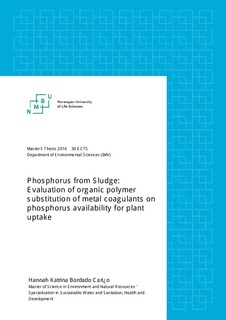| dc.contributor.advisor | Krogstad, Tore | |
| dc.contributor.advisor | Ratnaweera, Harsha | |
| dc.contributor.author | Cariño, Hannah Katrina | |
| dc.date.accessioned | 2016-08-11T11:28:24Z | |
| dc.date.available | 2016-08-11T11:28:24Z | |
| dc.date.issued | 2016-08-11 | |
| dc.identifier.uri | http://hdl.handle.net/11250/2398806 | |
| dc.description.abstract | Majority of Norwegian wastewater treatment plants utilize chemical treatments such as coagulation to meet high removal standards for phosphorus in wastewater. Up to 85% of the total sludge produced from these plants are supplied to farmers for use for possibility of reuse of nutrients, such as P, in agriculture. A study done by Tore Krogstad found that the plant availability of phosphorus from sludge is greatly reduced along with higher concentrations of metal coagulants. To enable wastewater treatment plants to continue meeting high removal efficiency while providing sludge with better P fertilizing capacity, some researches have suggested the substitution a part of the inorganic coagulants with cationic polymers.
In this study, varying combinations of dose and polymer additions with commonly used coagulants ALS and PAX are evaluated on their effective plant available phosphorus when applied to soil and hydroponics systems as fertilizer. Despite improving removal of total phosphorus from wastewater, the simultaneous addition of cationic polyacrylamide to metal salts in coagulation reduced dry mass harvest, most particularly from ALS, with yield reduction documented from 57.5% to 66.1%. Addition of polymers to PAX had a smaller harvest drop ranging from 0.8% to 27%. As compared to mineral fertilizers, nutrient use efficiencies at input P concentration of 6 kg P/daa of the different sludge types were all under 40%, going as low as 6% for ALS + polymer sludge.
Reduction of the yield could be attributed to residual positive charge from the polymer used in the sludge could that may have fixed negatively charged phosphates in the soil, the phytotoxic effect cationic polymers or the mobilization of Al in soil for plant uptake. Further studies are needed to point out the actual mechanism by which the positively-charged polymers inhibit plant growth.
Use of hydroponic growth systems generally reflected soil conditions in terms of plant mass harvest in response to the different sludge types. Yet, evaluations through soil growth were found necessary to address soil interactions not simulated in the hydroponics system such as effect on nutrient uptake. | nb_NO |
| dc.language.iso | eng | nb_NO |
| dc.publisher | Norwegian University of Life Sciences, Ås | |
| dc.subject | wastewater | nb_NO |
| dc.subject | coagulation | nb_NO |
| dc.subject | phosphorus | nb_NO |
| dc.subject | sludge | nb_NO |
| dc.subject | polymer | nb_NO |
| dc.title | Phosphorus from sludge : evaluation of organic polymer substitution of metal coagulants on phosphorus availability for plant uptake | nb_NO |
| dc.type | Master thesis | nb_NO |
| dc.subject.nsi | VDP::Agriculture and fishery disciplines: 900::Agriculture disciplines: 910::Management of natural resources: 914 | nb_NO |
| dc.subject.nsi | VDP::Technology: 500::Environmental engineering: 610 | nb_NO |
| dc.subject.nsi | VDP::Agriculture and fishery disciplines: 900::Agriculture disciplines: 910::Soil sciences: 913 | nb_NO |
| dc.subject.nsi | VDP::Technology: 500::Environmental engineering: 610 | nb_NO |
| dc.source.pagenumber | 47 | nb_NO |
| dc.description.localcode | M-MINA | nb_NO |
